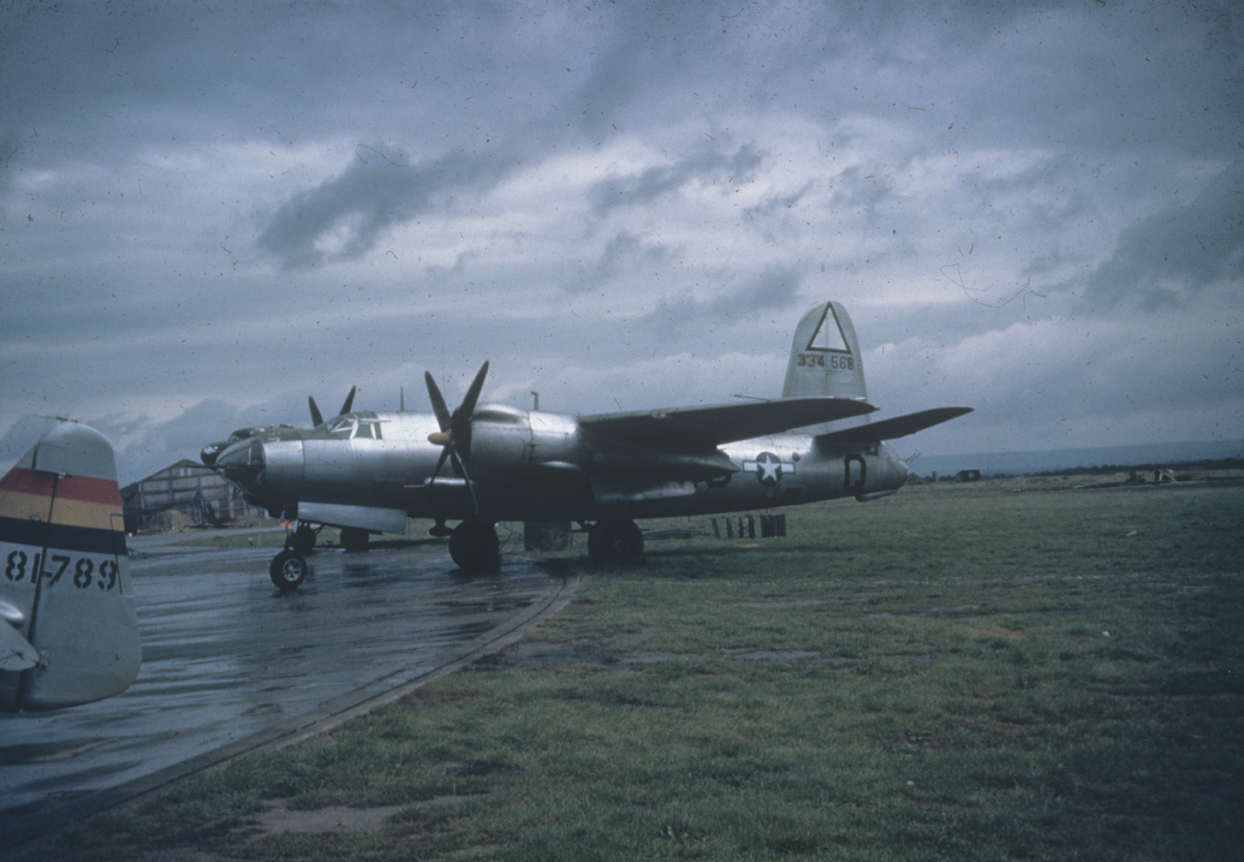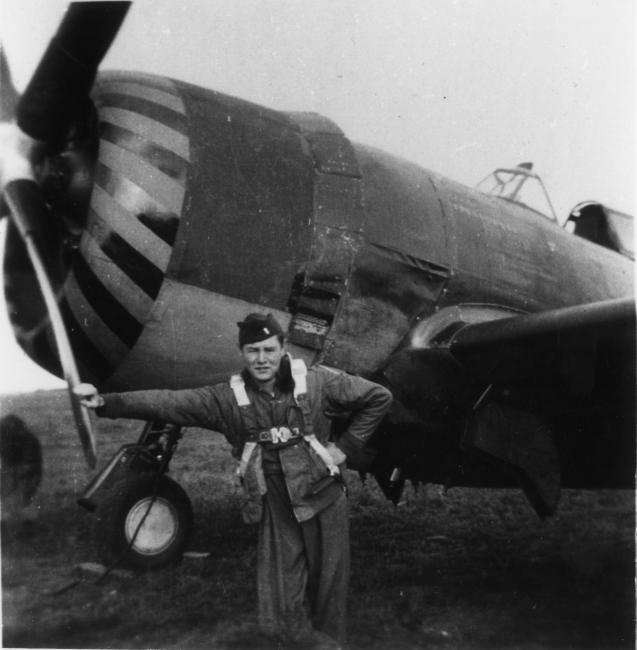405th Fighter Group
Group
IWM, Roger Freeman Collection
Object Number - FRE 7191 - A B-26 Marauder (K9-Q, serial number 43-34568) of the 344th Bomb Group with the tail of a P-47 Thunderbolt of the 405th Fighter Group in Germany....
The 405th Fighter Group was a fighter bomber unit of the United States Army Air Force in World War II. They group flew P-47 Thunderbolts in the European Theater of Operations (ETO) starting with the buildup to the Invasion of Normandy on "D-Day", through the end of the war in Europe. The 405th Fighter Group was a unit of the Ninth Air Force, IX Fighter Command, IX Tactical Air Command, 84th Fighter Wing. [1] The 405th was primarily assigned to support Patton's Third Army. The group consisted of the 509th, 510th, and 511th Fighter Squadrons, plus headquarters elements. The Group consisted of 73 aircraft.
The 405th (Dive) Bombardment Group was organized on 4 Feb 43, [2] at Drew Field near Tampa, Florida, and activated on 1 Mar 43.[2] The group was initially equipped with a few Douglas Dauntless and Curtis Helldiver dive bombers. The group gained some P-39 Airacobras before they left Drew. The group was redesignated as the 405th Fighter Bomber Group on 15 Aug 43. [3] In September, 1943, the group moved to Walterboro, South Carolina. In Walterboro, the group was outfitted with original "razorback" designed P-47 Thunderbolts. In February, 1944, the group moved by train to a point of embarkation (POE) camp near New York City. The group soon embarked onto the RMS Mauritania for transport to England. After six days at sea, in hurricane conditions, the group disembarked at Liverpool. The group traveled by train to Southampton, then, via lorries to Christchurch, Dorset.[4]
From 29 March to 29 June 44, the 405th operated out of the RAF Christchurch base. [5] After setting up camp and training over England, the group began combat operations over France. During this period their primary task was ground attack ahead of the coming invasion of Normandy, Operation Overlord. The group disrupted German positions and transportation infrastructure. Train locomotives were a favorite target. The group destroyed the Seine River bridge at Mantes-Gassicourt, northeast of Paris, just before the invasion, to inhibit movement of German materiel. [6] The group was grounded during the 6 June 44, invasion activities because Allied command was concerned that inexperienced antiaircraft batteries would mistake P-47s for German FW-190s. The 405th resumed flying on 10 June, providing close air support to the Normandy beachhead. On 18 June 44, [7] the group was redesignated the 405th Fighter Group. A few weeks after the invasion, the 405th packed up and moved to a POE near Southampton. [8]
While encamped at Christchurch, the Group officers bivouaced in Bure Homage, an English manor adjacent to the airfield that was requisitioned by the British Ministry of Defence for the war. [9]
The group's most notable action was the destruction of an entire German armored division near the town of Avranches, France on 29 July 1944. After immobilizing leading and trailing elements of the 3 mile long column, the rest of the tanks and trucks were systematically destroyed with multiple sorties.
The 405th also accepted the surrender of the highly decorated Luftwaffe ace, Hans Rudel, and his officers at the end of the war.
Connections
See how this entry relates to other items in the archive by exploring the connections below.
Unit stations
| Station | Location | Date |
|---|---|---|
|
Based |
Christchurch | 7 March 1944 - 30 July 1944 |
|
Based |
Picauville | 30 July 1944 - 14 August 1944 |
|
Based |
Saint-Dizier | 14 August 1944 - 9 February 1945 |
|
Based |
Ophoven | 9 February 1945 - 30 April 1945 |
Encompassing

- Unit Hierarchy: Platoon
- Air Force: Ninth Air Force
- Type Category: Air base

- Unit Hierarchy: Squadron
- Air Force: Ninth Air Force
- Type Category: Fighter

- Unit Hierarchy: Squadron
- Air Force: Ninth Air Force
- Type Category: Fighter

- Unit Hierarchy: Squadron
- Air Force: Ninth Air Force
- Type Category: Fighter
- Unit Hierarchy: Headquarters
- Air Force: Ninth Air Force
People

- Military/Civilian/Mascot: Military
- Nationality: American
- Unit: 405th Fighter Group 56th Fighter Group 511th Fighter Squadron 62nd Fighter Squadron
- Highest Rank: Flight Officer
- Role/Job: Fighter Pilot

- Military/Civilian/Mascot: Military
- Nationality: American
- Unit: 405th Fighter Group 510th Fighter Squadron
- Highest Rank: Major
- Role/Job: Pilot
- Military/Civilian/Mascot: Military
- Nationality: American
- Unit: 370th Fighter Group 405th Fighter Group 511th Fighter Squadron
- Highest Rank: First Lieutenant
- Military/Civilian/Mascot: Military
- Nationality: American
- Unit: 405th Fighter Group 509th Fighter Squadron
- Service Numbers: O-727390
- Highest Rank: Major

- Military/Civilian/Mascot: Military
- Unit: 405th Fighter Group 510th Fighter Squadron
- Highest Rank: First Lieutenant
- Role/Job: Fighter Pilot
Aircraft

- Aircraft Type: P-47 Thunderbolt
- Nicknames: Huckle De Buck
- Unit: 405th Fighter Group
- Aircraft Type: P-47 Thunderbolt
- Unit: 405th Fighter Group
- Aircraft Type: P-47 Thunderbolt
- Unit: 405th Fighter Group
- Aircraft Type: P-47 Thunderbolt
- Unit: 405th Fighter Group
- Aircraft Type: P-47 Thunderbolt
- Unit: 405th Fighter Group
Mission
- Date: 19 April 1944
- Date: 19 April 1944
Revisions
Stations added with details from:
- "Battle Colors Volume III - Insignia and Tactical Markings of the Ninth Air Force in World War Two' by Robert A. Watkins;
- http://www.ixengineercommand.com/airfields/physical.php
Drawn from the records of the National Museum of the Mighty Eighth Air Force, Savannah, Georgia / Paul Andrews, Project Bits and Pieces, 8th Air Force Roll of Honor database / Units in the UK from ETOUSA Station List, as transcribed by Lt. Col. Philip Grinton (US Army, Retired) and extracted by IWM; air division data from L.D. Underwood, based on the 8th Air Force Strength Report of 6th August 1944, as published in 'The 8th Air Force Yearbook' by Lt. Col. John H Woolnough (1980)









